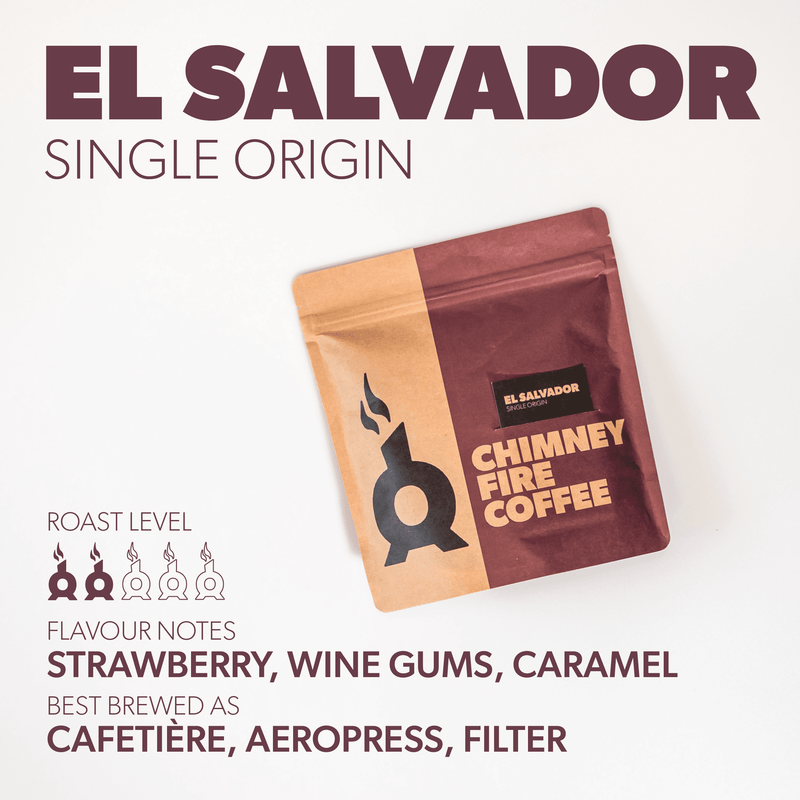Why Varietals are Important with Head Roaster Elizabeth Furth
During his visit to El Salvador in early 2019, Chimney Fire Coffee founder Dan was introduced to Tomas Trigueros, proprietor of the Don Tomas Estate. This group of four farms at altitudes exceeding 1200m lay in the Apaneca-Ilamatepec mountain range, close to the border with neighbouring Guatemala. They are on the slopes of the Santa Ana, an active stratovolcano on the eastern edge of the Pacific Ring of Fire.

Mother Nature has played her part in bringing high quality coffee to this area. In October 2005, the Santa Ana eruption left a thick layer of ash, while Hurricane Stan helped nutrients penetrate the soil. These simultaneous and disastrous natural phenomena caused widespread damage across the region, but farmers now reap the rewards. As noted in a report from NASA’s Earth Observatory, “For all its destructiveness, volcanic activity makes for fertile soil - and dilemmas. Attracted by the ability to grow good crops, along with the cooler temperatures that come with higher altitude, people often risk volcano hazards. Residents near Santa Ana proved no exception; many of the evacuees from the October 1 Santa Ana eruption had cultivated coffee beans in the region.”

Don Tomas’ farms produce a variety of exceptional coffees, and we brought three of them to the UK market with our popular tasting bundle El Salvador Three Ways. For 2021 we have refreshed this offering to highlight three of the varietals that Tomas grows at his El Cipres farm - Red Bourbon, Orange Bourbon, and Yellow Bourbon. Our Head Roaster Elizabeth tells us a little more about what to expect, and why the type of coffee cherry is an exciting part of the coffee tasting experience.
“When it comes to tasting coffee (and roasting it for that matter), there is more to these little beans than first meets the eye. Discerning coffee drinkers will notice that different coffees offer different flavour profiles and different textural characteristics. Many wine drinkers are familiar with the nuances of wines from different regions, climates, and soil, as well as the variety that different grapes present to the drinking and enjoyment of wines.
Well, as I will explain, when it comes to uncovering the reasons for the different tastes in coffees, the comparison between wine and coffee is a closer one than one would think. In coffee (as in wine) there are different varietals, whose unique characteristics lead the way in what we can taste when enjoying these drinks. Origins, altitude, climate, soil, and processing methods are usually the first noticeable distinctions consumers are guided towards.
However, I’d like to draw your attention to a further distinction, the varietal of the coffee. In the Arabica coffee species there are lots of subdivisions - these are the varietals. At the base of the Arabica coffees we find Typica and Bourbon, and from these two prime varietals many more have branched off.

Bourbon varietals are real favourites of mine. We have the Red Bourbon, where the skin of the ripe coffee cherry is red. Then we have the Orange Bourbon, and (like the name suggests) the skin of the ripe cherry is, you guessed it, orange. Furthermore, there is also the Yellow Bourbon varietal where her skin is a lovely rich dark yellow.
When it comes to the flavour characteristics of these three Bourbon varietals, the colours speak volumes. Think red, juicy fruits, and you will notice that the varietal is most likely to be a washed Red Bourbon. The Orange Bourbon comes very close to a super sweet tangerine - it offers a more gentle acidity compared to the Red. As for the Yellow Bourbon, its characteristics are different again. Depending on the origin (such as the Yellow Bourbon from Brazil), it has more of a nutty, chocolatey quality. More recently the Pink Bourbon (found mainly in Colombia) has made quite an impact in the coffee world with its gentle, floral acidity. The sizes of these four varieties are also slightly different.
It is important to note that the process of every varietal (for example natural, washed, or honey) will change the flavour profile too. These nuances are particularly noticeable when it comes to the mouthfeel and sweetness.
Similar to the various grape varietals in wine, certain coffee varietals are found to grow very well in more than one country or continent. Tasting a Red Bourbon grown in Rwanda next to a Red Bourbon from El Salvador, for example, adds another dimension to the discerning coffee drinker.

When roasting I want to stay true to the varietals, as well as staying true to the origin of the beans. Knowing the inherent characteristics of different varietals helps in assessing my roasting approach. My main aim lies in respecting these individual and natural characteristics. I truly hope you will enjoy tasting the different characteristics of these three varietals from El Salvador.”
El Salvador El Cipres
From £11.50
FILTER ROAST / LIGHT
STRAWBERRY, WINE GUMS, CARAMEL





